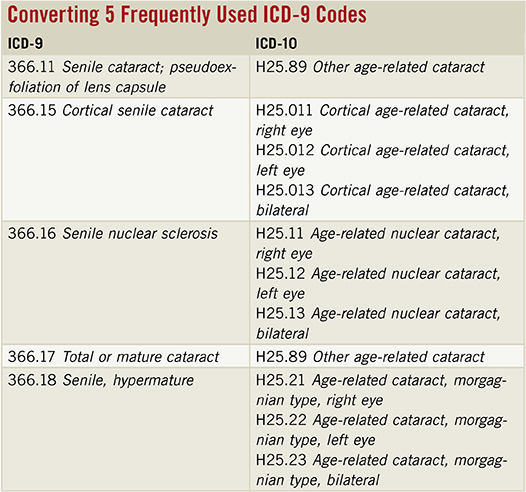By Sue Vicchrilli, COT, OCS, Academy Director of Coding and Reimbursement, Jenny Edgar, CPC, CPCO, OCS, Academy Coding Specialist, and Rajiv Rathod, MD, MBA
Download PDF
How many different types of cataracts are there? According to ICD-10-CM, there are close to 70— ranging from age-related to zonular cataracts.
Reporting laterality. For some codes, you include a number to indicate laterality: 1 for the right eye, 2 for the left eye, and 3 for both eyes. For most codes that require laterality, you report this number as the sixth character (e.g., H21.22- Degeneration of ciliary body), but there are some codes where it appears as the fifth character (e.g., H26.3-, Drug-induced cataract). And for other codes, you don’t report laterality at all.
Where to Find Cataract Codes
In ICD-10’s Tabular List, check the following chapters for cataract codes.
- Chapter 7 Eye and ocular adnexa. See the Disorders of lens section (H25H28) for the most-used diagnoses. (For an ICD-9/ICD-10 conversion table of the most common ICD-9 cataract codes, see the Web Extra below.)
- Chapter 4 Endocrine, nutritional and metabolic diseases. Examples include E10.36 Type 1 diabetes with diabetic cataract, E11.36 Type 2 diabetes with diabetic cataract, E20.9 Hypoparathyroidism, unspecified, E46 Unspecified protein-calorie malnutrition, E34.9 Endocrine disease, unspecified, E74.21 Galactosemia, and E88.9 Metabolic disorder, unspecified.
- Chapter 17 Congenital malformations, deformations, and chromosomal abnormalities. Example: Q12.0- represents anterior and posterior axial embryonal, pyramidal, blue, central, cerulean, congenital, coralliform, coronary, and crystalline cataracts.
- Chapter 6 Diseases of the nervous system. Example: G71.19 Other specified myotonic disorders.
|
Web Extra: Savvy Coder
|
 |
Complex Cataract Surgery—66982
When you submit CPT code 66982, local coverage determinations (LCDs) require more than the traditional cataract diagnosis codes. To indicate why the surgery qualifies as complex, you also must report one of the following codes:
H21.221 Degeneration of ciliary body, right eye
H21.222 Degeneration of ciliary body, left eye
H21.261 Iris atrophy (essential) (progressive), right eye
H21.262 Iris atrophy (essential) (progressive), left eye
H21.271 Miotic pupillary cyst, right eye
H21.272 Miotic pupillary cyst, left eye
H21.29 Other iris atrophy
H21.531 Iridodialysis, right eye
H21.532 Iridodialysis, left eye
H21.561 Pupillary abnormality, right eye
H21.562 Pupillary abnormality, left eye
H21.81 Floppy iris syndrome
H21.89 Other specified disorders of iris and ciliary body
H21.9 Unspecified disorder of iris and ciliary body
H22 Disorders of iris and ciliary body in diseases classified elsewhere
H57.00 Unspecified anomaly of pupillary function
H57.01 Argyll Robertson pupil, atypical
H57.02 Anisocoria
H57.03 Miosis
H57.04 Mydriasis
H57.051 Tonic pupil, right eye
H57.052 Tonic pupil, left eye
H57.09 Other anomalies of pupillary function
H57.9 Unspecified disorder of eye and adnexa
Q13.1 Absence of iris
Q13.9 Congenital malformation of anterior segment of eye, unspecified
YAG Capsulotomy—66821
When submitting CPT code 66821, you can use these codes to indicate medical necessity:
H26.491 Other secondary cataract, right eye
H26.492 Other secondary cataract, left eye
H26.493 Other secondary cataract, bilateral